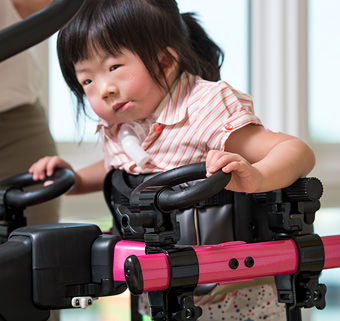New Webinar on Motor Learning
Progressive Gait Training
| April 2018
On April 12, we hosted a webinar, Progressive Gait Training: Motor Learning Strategies and the Research, discussing motor skill acquisition through practice, feedback and prompt reduction. It concluded with a demonstration of the Rifton Pacer and tips for therapeutic and functional use of the Pacer emphasizing the benefits of dynamic support and the reduction of physical assistance to increase independence in gait. You can watch the recording or read the transcript here.
Two of the questions submitted by attendees will be of interest to the whole group so I’ll share them here along with my response:
Q & A
Question
Can you make the thigh prompts only anterior-posterior to prevent adduction considering they have the capacity to adduct?
Answer
Good question. Without a client positioned in the gait trainer (see webinar recording 41:10-42:15) this webinar did not fully demonstrate the thigh prompt adjustment and movement. By tightening the knobs on the thigh prompt the height of the leg cuff and the amount of ab/adduction can be controlled. Then, the thigh prompts will only move in an anterior-posterior direction. The key is to make sure to tighten both knobs.
This video demonstrates the thigh prompt in more detail and with actual clients.
Question
Which prompts would you recommend for a child who has hypotonia and very wide base of support, who tends to fall into whatever support is given to him but also fatigues easily and loses his balance?
Answer
Pacer positioning: Consider using the dynamic upper frame and the multi-position saddle (MPS) in the reverse or posterior position. Because of the vertical up-down motion of the dynamic upper frame with the attached MPS, the child will be less likely to “sit” or “hang-out” with knees flexed; instead, the downward motion will prompt the child to put weight through the feet while still providing weight bearing assist. With the open space in front (using the Pacer as a posterior walker) this may also visually encourage a more upright stance. With your evaluation of positioning you will discover if posture is further improved with an angle of the saddle to promote a slight anterior pelvic tilt.
By securing the child’s forearms in the arm prompts or arm platforms it may be possible to remove the chest prompt or perhaps widen or lower it to reduce dependence on this prompt. Use of the thigh prompts as well may help position the legs into a more adducted position. Placing the swivel locks and one-way ratchet control on the casters will limit extraneous or unintended movement and help reduce effort in early learning.
Positioning in the Pacer is certainly a key aspect of gait training as this allows us to modify the nominal task difficulty. Taking motor learning concepts into account, we will also want to consider the age and ability of the child as well as stage of learning, and to consider the environment and context of the walking task. All of these have an impact on functional task difficulty. Here are examples of further considerations and strategies that could be helpful:
Salience: The sense of purpose and relevance of walking is key for motivation. The MOVE Curriculum asks, “To walk where? To do what?” So, for example, you might try walking a shorter distance to a mealtime to create more focus and urgency for the child.
Distributed Practice: Doing shorter walking practice sessions more than once a day will promote more motor learning and allow the child to build leg strength and core control while reducing fatigue.
External Focus: Think creatively to achieve an environmental or task context that will encourage the desired motor performance. For example, we’ve seen how a long strip of bubble wrap placed in the hallway in line with the child’s feet can motivate a child to perform more active weight bearing with each step. A mirror placed farther along and high up on the hallway wall may motivate a child to walk forward with a more upright posture in order to see in the mirror. A balloon suspended to hang from the ceiling may encourage the child to stand taller to bump it with his or her head. Use of roller skates strapped to the child’s shoes may add meaning and fun while challenging postural control and generating movement of the feet.
Verbal feedback: Where possible, limit or avoid verbal instruction or correction that focuses on the child’s own body positioning. Rather provide verbal instruction or knowledge-of-results feedback that focuses on the environment or task outcome (such as destination or activity). Remember that giving frequent feedback may not necessarily be helpful – delay your verbal feedback and give time for practice attempts. And remember that both negative-corrective feedback AND positive-praise feedback are important.
Peer Modeling: Peers (whether typically developing or with physical disabilities) can assist in providing demonstration/visual feedback as well as companionship and motivation.
Transfer-appropriate Training: As the child gains in postural strength and control when walking, it will be possible to transition practice from a fun and motivating activity in a controlled environment to actual use of the skill in real-life contexts with gradually increased environmental distractions and/or dual-tasking to add to the task difficulty and thereby improve generalization of the skill.




